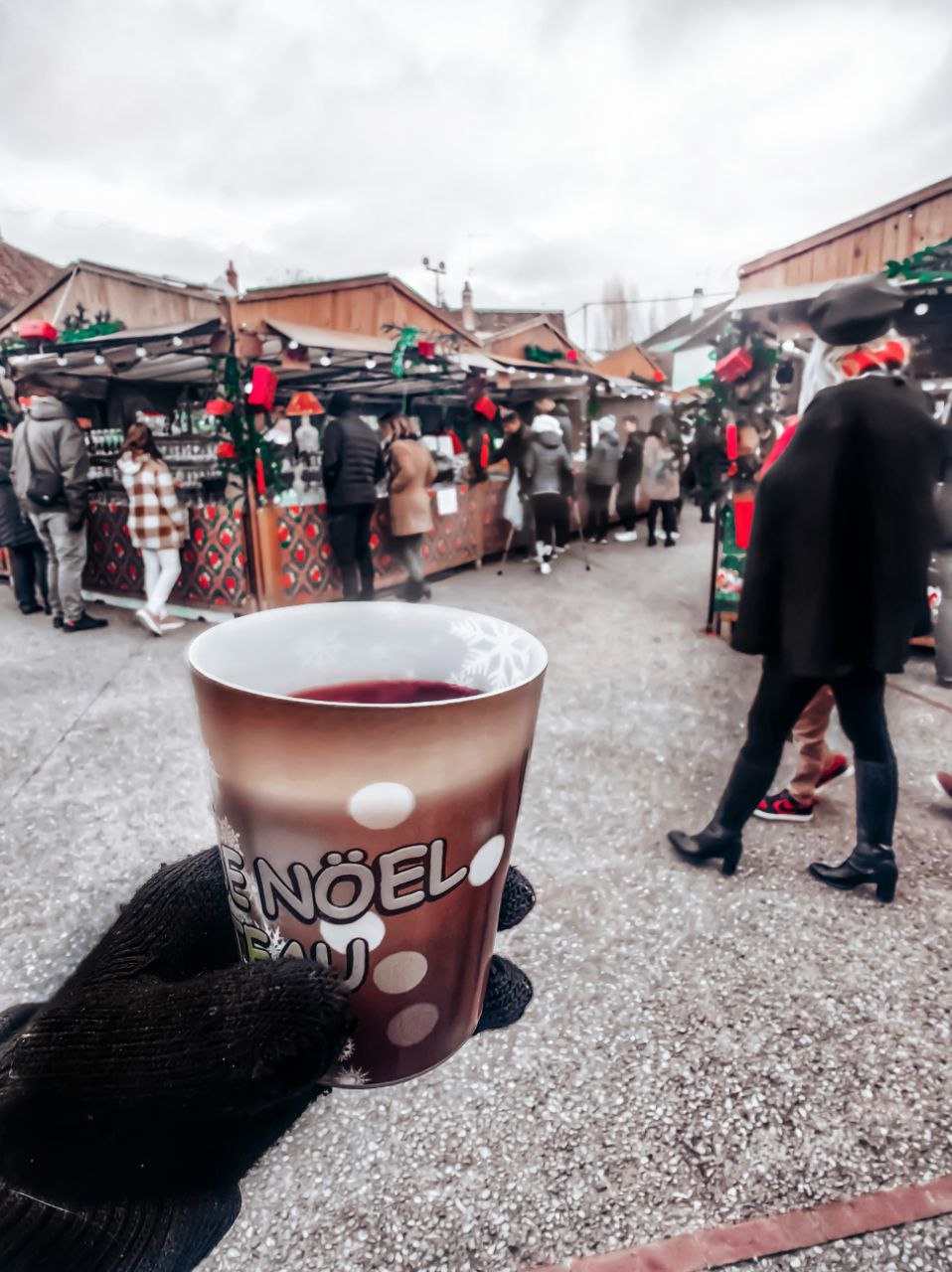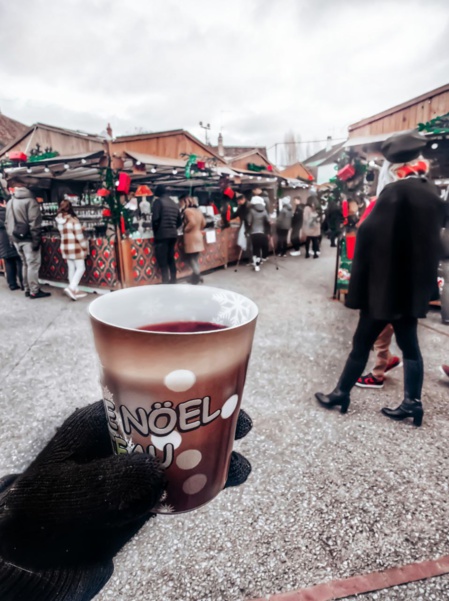Oh la la, mulled wine—a winter classic that's not just about staying on trend but also a delicious hug. Beyond its centuries heritage, this winter elixir has undergone a remarkable resurgence, finding its place not just in the heartwarming narratives of traditional festivities but also in the glamorous landscapes of social media feeds, silver screens, and elite gatherings.
On platforms like Instagram, mulled wine reigns as a seasonal muse, against rustic backdrops adorned with flickering candlelight. Influencers alike praise this steaming concoction as an emblem of coziness and sophistication in the essence of winter. Moreover, its cameo appearances in popular films (or all Christmas movies actually!) and television series, where characters gather around fire places, mugs in hand, have catapulted mulled wine into the winter drink to have with hot chocolate of course ! From scenes of historical dramas set in medieval banquets to contemporary romantic comedies, this aromatic brew, blends into the visual tapestry of storytelling, becoming an indispensable prop that symbolizes warmth, conviviality, and refined taste.
Beyond its fashionable façade, mulled wine is a delight. Its aromatic mix of spices and rich, velvety flavors doesn’t just warm you from the inside out. Each variation of mulled wine carries its own charm, comfort, and a sense of festivity. A timeless pleasure but also a world cultural icon that transcends generations.
Here are 4 secrets about this popular beverage that might surprise you!
On platforms like Instagram, mulled wine reigns as a seasonal muse, against rustic backdrops adorned with flickering candlelight. Influencers alike praise this steaming concoction as an emblem of coziness and sophistication in the essence of winter. Moreover, its cameo appearances in popular films (or all Christmas movies actually!) and television series, where characters gather around fire places, mugs in hand, have catapulted mulled wine into the winter drink to have with hot chocolate of course ! From scenes of historical dramas set in medieval banquets to contemporary romantic comedies, this aromatic brew, blends into the visual tapestry of storytelling, becoming an indispensable prop that symbolizes warmth, conviviality, and refined taste.
Beyond its fashionable façade, mulled wine is a delight. Its aromatic mix of spices and rich, velvety flavors doesn’t just warm you from the inside out. Each variation of mulled wine carries its own charm, comfort, and a sense of festivity. A timeless pleasure but also a world cultural icon that transcends generations.
Here are 4 secrets about this popular beverage that might surprise you!
1) Mulled Wine thru History
Throughout history and into the present day, mulled wine has retained its cultural significance. It’s not just a drink; it's a symbol of conviviality, warmth, and celebration during the festive winter season, bringing people together in a shared appreciation for its comforting flavors and historical roots that are as diverse as its ingredients. Indeed, the roots of mulled wine trace back to ancient civilizations. The Romans were among the first to heat wine and infuse it with spices. They called it "Conditum Paradoxum," a blend of wine, spices like cinnamon, cloves, and even honey. It was considered not just a drink but also a symbol of wealth and social status.
During the Middle Ages, spiced wine gained popularity across Europe. It was known as "hippocras" in France, named after the renowned physician Hippocrates. The recipe evolved with regional variations, incorporating local herbs, fruits, and spices. It was served at feasts and banquets among the nobility and became synonymous with merriment and celebration. Mulled wine wasn’t just a drink; it was associated with rituals and traditions. In Scandinavian countries, for instance, it was called "glögg." It was often prepared during the winter solstice celebrations, featuring spices like cardamom, almonds, and raisins. These variations were shared as a symbol of warmth and togetherness during the cold winter months.
With colonial expansion, mulled wine made its way to different parts of the world. Colonial America had its version, known as "wassail," a spiced cider often used in ceremonies to bless apple orchards and encourage a good harvest. Today, mulled wine remains a beloved winter drink, enjoyed worldwide with both traditional and modern twists. While the basic recipe of red wine infused with spices remains unchanged, contemporary variations include adding citrus fruits, brandy, or experimenting with different wine varietals. There's also a rising demand for non-alcoholic versions, catering to diverse preferences and health considerations.
During the Middle Ages, spiced wine gained popularity across Europe. It was known as "hippocras" in France, named after the renowned physician Hippocrates. The recipe evolved with regional variations, incorporating local herbs, fruits, and spices. It was served at feasts and banquets among the nobility and became synonymous with merriment and celebration. Mulled wine wasn’t just a drink; it was associated with rituals and traditions. In Scandinavian countries, for instance, it was called "glögg." It was often prepared during the winter solstice celebrations, featuring spices like cardamom, almonds, and raisins. These variations were shared as a symbol of warmth and togetherness during the cold winter months.
With colonial expansion, mulled wine made its way to different parts of the world. Colonial America had its version, known as "wassail," a spiced cider often used in ceremonies to bless apple orchards and encourage a good harvest. Today, mulled wine remains a beloved winter drink, enjoyed worldwide with both traditional and modern twists. While the basic recipe of red wine infused with spices remains unchanged, contemporary variations include adding citrus fruits, brandy, or experimenting with different wine varietals. There's also a rising demand for non-alcoholic versions, catering to diverse preferences and health considerations.
2) The Art of Crafting: A Perfect Blend
One of the renowned French chefs known for his expertise in traditional cuisine and recipes is Michel Roux Jr. Trained in esteemed kitchens across France and the UK, Roux Jr.'s transformative tenure at Le Gavroche, maintaining its three Michelin stars, solidifies his reputation as an exceptional chef. Beyond his culinary prowess, Roux Jr. has become a familiar face on television, featuring prominently in cooking shows such as "MasterChef: The Professionals" and "Saturday Kitchen." His dedication to preserving and evolving the heritage of French cuisine, blending tradition with innovation, has cemented his status as a culinary luminary.
His recipe for mulled wine isn't just a blend of ingredients; it's a masterpiece derived from his dedication to preserving the essence of French cuisine:
Ingredients:
1 bottle of red wine (preferably a robust French red, like a Bordeaux)
1 orange, sliced
1 lemon, sliced
1 cinnamon stick
3 cloves
1 star anise
50g (about 1/4 cup) sugar or to taste
Brandy or Cognac (optional)
Additional spices like cardamom or nutmeg (optional for personal taste)
Instructions:
Pour the red wine into a large saucepan or pot and place it on low heat. Avoid boiling the wine as it can alter its flavors. Add the sliced orange and lemon to the wine. Ensure they are fresh and thoroughly washed beforehand. Drop in the cinnamon stick, cloves, and star anise into the pot. These spices will infuse the wine with their aromatic flavors. Sweeten the mixture by slowly adding sugar, stirring continuously. Adjust the sweetness according to your taste preference. Allow the wine to gently warm for about 20-30 minutes. This allows the flavors to meld together without overheating the wine. Optional: For an extra kick, add a splash of brandy or cognac to the mix. It adds depth to the flavor profile. Once warmed through and infused with the spices, remove the pot from the heat. Strain the mulled wine to remove the spices and fruit slices. This step ensures a smoother texture without any residual bits.
Serve the mulled wine in heatproof glasses or mugs. Garnish with a fresh cinnamon stick or citrus twist for a visually appealing touch.
His recipe for mulled wine isn't just a blend of ingredients; it's a masterpiece derived from his dedication to preserving the essence of French cuisine:
Ingredients:
1 bottle of red wine (preferably a robust French red, like a Bordeaux)
1 orange, sliced
1 lemon, sliced
1 cinnamon stick
3 cloves
1 star anise
50g (about 1/4 cup) sugar or to taste
Brandy or Cognac (optional)
Additional spices like cardamom or nutmeg (optional for personal taste)
Instructions:
Pour the red wine into a large saucepan or pot and place it on low heat. Avoid boiling the wine as it can alter its flavors. Add the sliced orange and lemon to the wine. Ensure they are fresh and thoroughly washed beforehand. Drop in the cinnamon stick, cloves, and star anise into the pot. These spices will infuse the wine with their aromatic flavors. Sweeten the mixture by slowly adding sugar, stirring continuously. Adjust the sweetness according to your taste preference. Allow the wine to gently warm for about 20-30 minutes. This allows the flavors to meld together without overheating the wine. Optional: For an extra kick, add a splash of brandy or cognac to the mix. It adds depth to the flavor profile. Once warmed through and infused with the spices, remove the pot from the heat. Strain the mulled wine to remove the spices and fruit slices. This step ensures a smoother texture without any residual bits.
Serve the mulled wine in heatproof glasses or mugs. Garnish with a fresh cinnamon stick or citrus twist for a visually appealing touch.
3) The Health Benefits: Between spices and treat
Between its delicious taste, mulled wine offers surprising health benefits. Investigate the potential advantages of its ingredients, such as antioxidants from spice. Consulting with health experts further validates these potential benefits. They often emphasize the importance of moderation when consuming alcoholic beverages, including mulled wine. Moderation is key to harnessing potential health benefits while avoiding the adverse effects of excessive alcohol consumption.
- Antioxidants from Spices:
Mulled wine owes much of its flavor to spices like cinnamon, cloves, and star anise. These spices are rich in antioxidants, which play a crucial role in combating oxidative stress and reducing inflammation in the body. Cinnamon, in particular, contains polyphenols that exhibit strong antioxidant properties, potentially aiding in overall health.
- Potential Cardiovascular Benefits:
The presence of certain compounds in red wine, like resveratrol, has been associated with potential cardiovascular benefits. Resveratrol, found in grape skins, is linked to promoting heart health by supporting healthy blood vessels and potentially reducing the risk of heart disease when consumed in moderation.
- Positive Impact on Digestion:
The blend of spices used in mulled wine, such as cloves and star anise, has historically been linked to aiding digestion. These spices are believed to possess digestive properties, potentially assisting in alleviating discomfort and supporting healthy digestion after a meal.
- Relaxation and Stress Reduction:
Moderate consumption of mulled wine, particularly when enjoyed in a relaxed setting, may contribute to stress reduction and relaxation. The warmth and comforting qualities of the beverage, coupled with the aromatic spices, could create a calming effect, promoting a sense of well-being.
However, once again, it's essential to note that the benefits are modest and can vary among individuals. It's always recommended to enjoy alcoholic beverages responsibly and as part of a balanced lifestyle.
- Antioxidants from Spices:
Mulled wine owes much of its flavor to spices like cinnamon, cloves, and star anise. These spices are rich in antioxidants, which play a crucial role in combating oxidative stress and reducing inflammation in the body. Cinnamon, in particular, contains polyphenols that exhibit strong antioxidant properties, potentially aiding in overall health.
- Potential Cardiovascular Benefits:
The presence of certain compounds in red wine, like resveratrol, has been associated with potential cardiovascular benefits. Resveratrol, found in grape skins, is linked to promoting heart health by supporting healthy blood vessels and potentially reducing the risk of heart disease when consumed in moderation.
- Positive Impact on Digestion:
The blend of spices used in mulled wine, such as cloves and star anise, has historically been linked to aiding digestion. These spices are believed to possess digestive properties, potentially assisting in alleviating discomfort and supporting healthy digestion after a meal.
- Relaxation and Stress Reduction:
Moderate consumption of mulled wine, particularly when enjoyed in a relaxed setting, may contribute to stress reduction and relaxation. The warmth and comforting qualities of the beverage, coupled with the aromatic spices, could create a calming effect, promoting a sense of well-being.
However, once again, it's essential to note that the benefits are modest and can vary among individuals. It's always recommended to enjoy alcoholic beverages responsibly and as part of a balanced lifestyle.
4) The best Mulled wine around the world
The "best" mulled wine around the world represents the cultural traditions and regional preferences of its origin, mixologists and chefs continuously reinvent classic recipes. What makes these versions stand out are the unique combinations of spices, choice of wine, and sometimes added local ingredients that offer a distinctive and comforting winter beverage. Here is a list of what we can consider as the top Mulled wine:
- Glühwein (Germany):
In Germany, Glühwein takes the spotlight during the festive Christmas markets. It's typically made with red wine infused with cloves, cinnamon, citrus, and sometimes a splash of rum. The atmosphere of the markets, combined with the aromatic warmth of Glühwein, makes it a beloved winter tradition.
- Vin Chaud (France):
Vin Chaud, meaning "hot wine" in French, is a staple in French winter culture. Prepared with red wine, often a Bordeaux or Burgundy, it's steeped with spices like cinnamon, cloves, and sometimes citrus peels. It's enjoyed during winter festivities, providing a comforting blend of flavors.
- Glögg (Nordic Countries):
Glögg hails from Nordic countries like Sweden and Norway. This mulled wine often incorporates almonds, raisins, and a mix of spices that can include cardamom, ginger, and cloves. It's traditionally served with gingerbread or other festive treats.
- Mulled Wine in the UK:
In the UK, mulled wine is a popular choice during the holiday season. It's prepared with red wine, often combined with spices like cinnamon, cloves, and star anise. Sometimes, additional ingredients like citrus fruits or a dash of brandy are added for depth of flavor.
- Spanish Mulled Wine (Spain):
Spain has its version called "vino caliente," made with red wine, cinnamon, citrus peels, and sweetened with sugar or honey. It's enjoyed during the winter months and often accompanies holiday celebrations.
- Mulled Wine in Eastern Europe:
In Eastern European countries like Hungary and Czech Republic, mulled wine, known as "forralt bor" and "svařák" respectively, follows similar recipes with variations in spices, sometimes incorporating local flavors like honey or fruit juices.
- Glühwein (Germany):
In Germany, Glühwein takes the spotlight during the festive Christmas markets. It's typically made with red wine infused with cloves, cinnamon, citrus, and sometimes a splash of rum. The atmosphere of the markets, combined with the aromatic warmth of Glühwein, makes it a beloved winter tradition.
- Vin Chaud (France):
Vin Chaud, meaning "hot wine" in French, is a staple in French winter culture. Prepared with red wine, often a Bordeaux or Burgundy, it's steeped with spices like cinnamon, cloves, and sometimes citrus peels. It's enjoyed during winter festivities, providing a comforting blend of flavors.
- Glögg (Nordic Countries):
Glögg hails from Nordic countries like Sweden and Norway. This mulled wine often incorporates almonds, raisins, and a mix of spices that can include cardamom, ginger, and cloves. It's traditionally served with gingerbread or other festive treats.
- Mulled Wine in the UK:
In the UK, mulled wine is a popular choice during the holiday season. It's prepared with red wine, often combined with spices like cinnamon, cloves, and star anise. Sometimes, additional ingredients like citrus fruits or a dash of brandy are added for depth of flavor.
- Spanish Mulled Wine (Spain):
Spain has its version called "vino caliente," made with red wine, cinnamon, citrus peels, and sweetened with sugar or honey. It's enjoyed during the winter months and often accompanies holiday celebrations.
- Mulled Wine in Eastern Europe:
In Eastern European countries like Hungary and Czech Republic, mulled wine, known as "forralt bor" and "svařák" respectively, follows similar recipes with variations in spices, sometimes incorporating local flavors like honey or fruit juices.













 Haute joaillerie dreams: JOVADI's Carousel of Inspiration
Haute joaillerie dreams: JOVADI's Carousel of Inspiration








